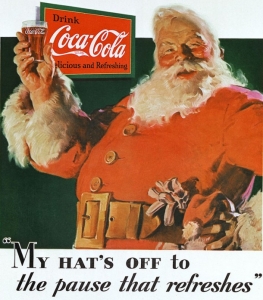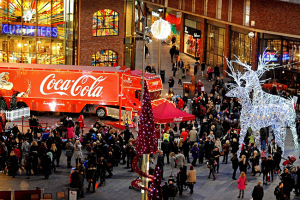In the 1931, Coca-Cola hired Swedish-American artist Haddon Sundblom to create an image of Santa for use in their seasonal advertising.

Even now, 85 years later, the resulting depiction of the jolly, old elf remains a staple of the holiday, and many have attributed the modern look of Santa to Sundblom and Coke.
Is it true, or is it coincidence that Santa dresses in red and white to this day?
As it turns out, it is coincidence, but one used with such skill by Coca-Cola that it became a major stepping stone in transitioning them from a company selling only nine bottles a day at 5c a piece, to a global powerhouse that would define the power of advertising.
The truth is that in 1931, the image of Santa was still evolving. While some companies depicted him as a slender elf, others portrayed a stern giant. His red and white garb was just one of many Santa was seen to wear up until that time.
So while Coke did not invent the modern day Santa, their vision of a happy, rosy-cheeked, grandfather figure in the company’s colours became a season staple that consumers connected with to the point of obsession. On one occasion, Santa’s belt buckle was facing the wrong way, and people wrote to complain. Some time later, he was depicted without a wedding ring, and the public raised a Coke in memory of Mrs Claus.
The company employed Santa in much of their Christmas advertising between 1931 and 1964, the year Sundblom painted his final version. Previous campaigns were intermittently revitalised, and in 2001, Academy Award-winning animator Alexandre Petrov created a commercial using what remained of the original artworks.
Even when Santa was retired, the connection between Christmas and Coke remained ingrained in cultures worldwide. In the U.K., for instance, a Coca-Cola Christmas truck tours the country for a month celebrating a commercial in 1995 that was appropriated for use in over 100 countries.

The myth of Coke’s Santa has been debunked, but so what? For so many people, the festive season still begins when a cartoon polar bear rolls onto their TV (in ads produced by Ridley Scott, no less), or when a bright red beverage truck rolls into town.
Can you think of other examples where companies have connected themselves with cultural icons or events through brilliant advertising? Let us know in the comments.
